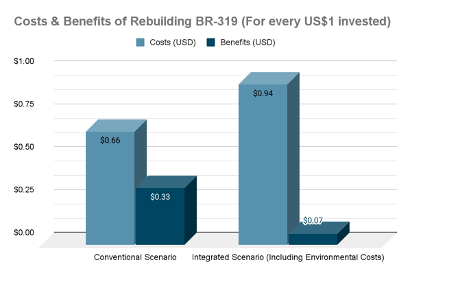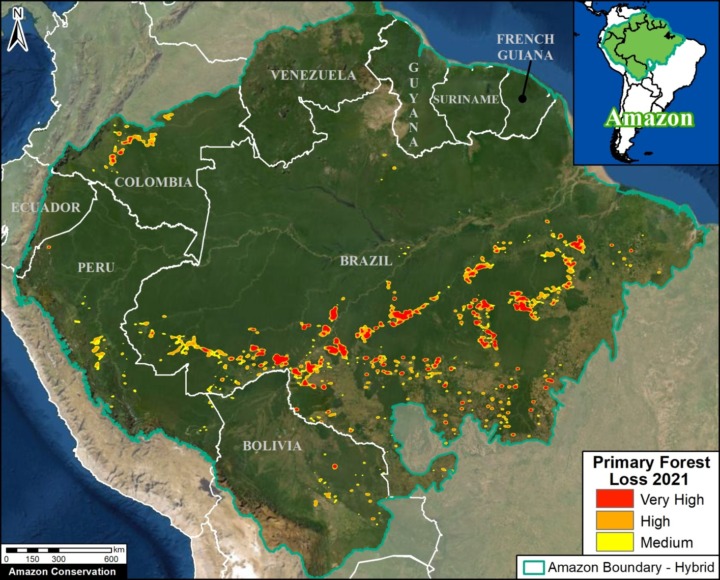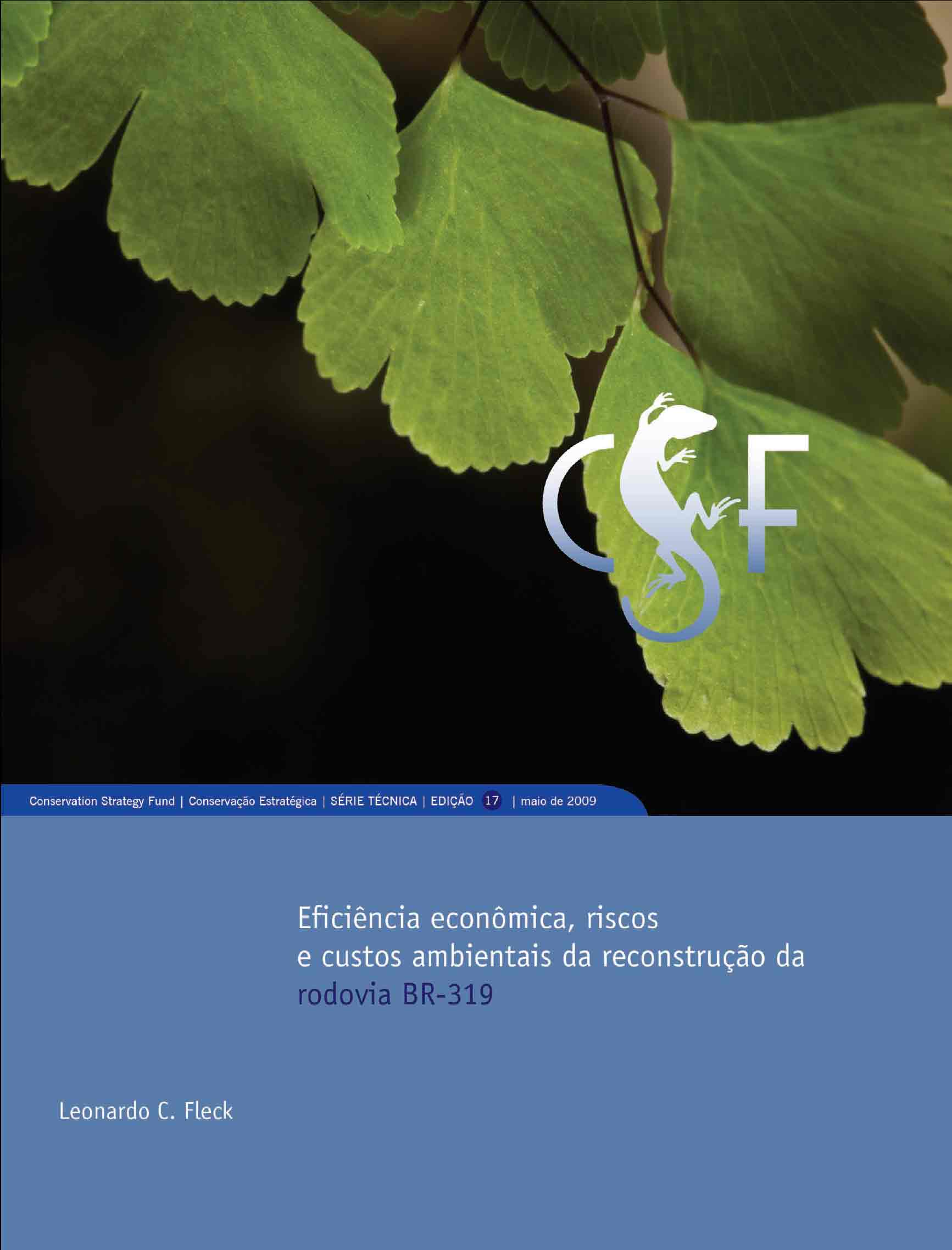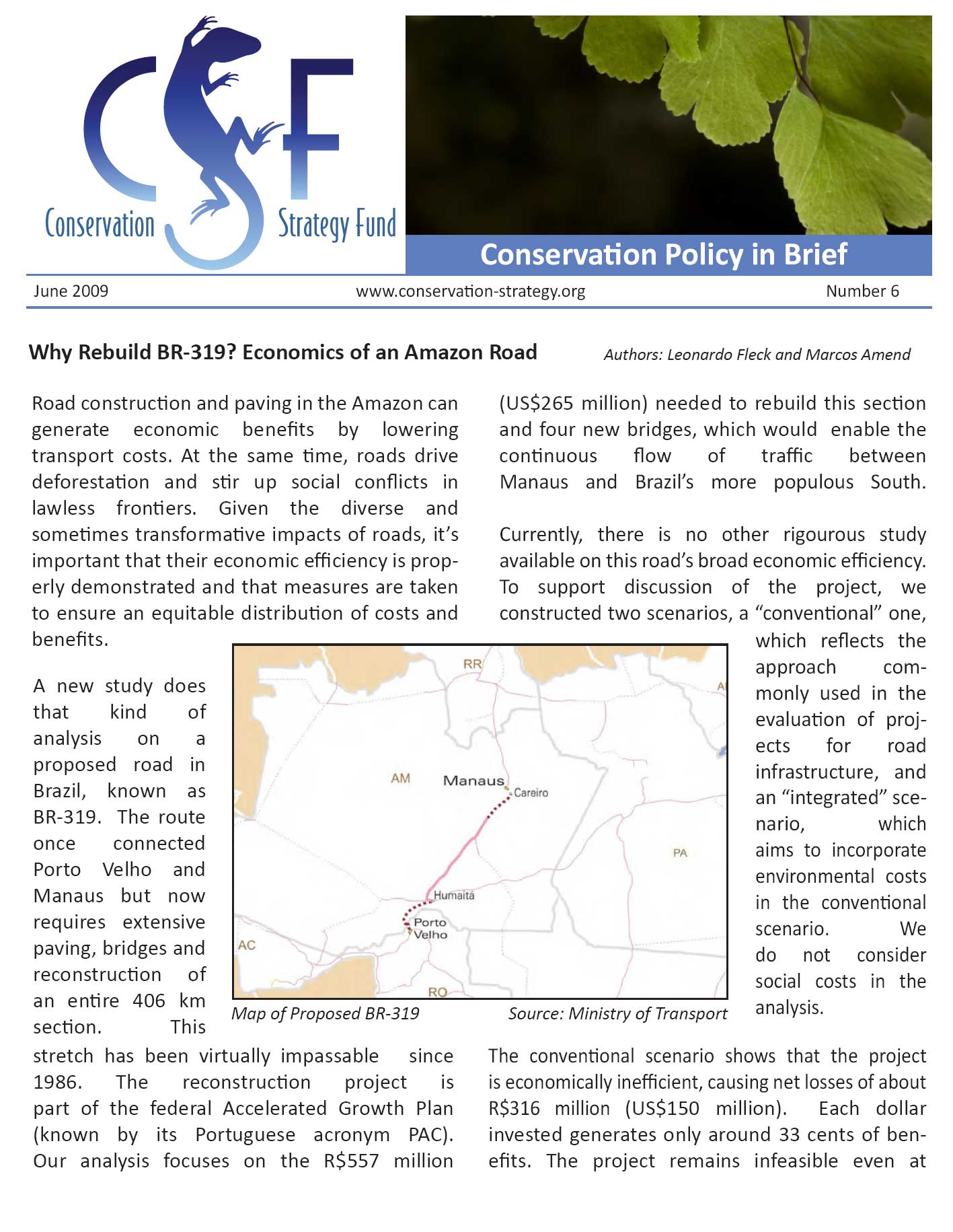Brazil to Rebuild a Highway Through the Amazon, but At What Cost? CSF Infrastructure Experts Weigh in
| Conservation Strategy Fund’s Smart Infrastructure Series communicates our expertise in sustainable infrastructure development around the world. In this series, our team of expert economists share their advice on balancing development with the conservation of healthy ecosystems for short and long-term social, economic, and environmental well-being. |
Brazil to Rebuild a Highway Through the Amazon, but At What Cost?
CSF Infrastructure Experts Weigh in
When it comes to the math of improving one of the world’s most controversial roads, BR-139, it’s important to include all the numbers. At first glance, paving BR-139 might seem a good choice; after all, paved roads lower transportation costs, enable more efficient trade, and improve access to health services and schools. However, in our analysis of the road, these benefits don’t outweigh the financial costs, and may result in an estimated loss of US$150 million. When factoring in the additional environmental impacts, this loss increases to over US$ 1 billion, and further threatens the Amazon rainforest and the communities living in it.
In July, the government of Brazil granted a preliminary environmental license for rebuilding and paving 405 kilometers (km) of the national road BR-319 which would connect the untouched and indigenous-managed areas of the Amazon rainforest with the "arc of deforestation”. This road would connect Manaus, the capital of Amazonas, to Porto Velho, the capital of Rondônia. According to Brazil’s Ministry of Infrastructure, rebuilding and paving this road would provide local municipalities with a more efficient mode of transportation and the necessary infrastructure to connect Amazonas to the rest of the country. However, our study shows that those stated benefits would not outweigh the exceptionally high social and environmental costs of this infrastructure project (Fleck 2009).
Ten years ago, we concluded in our economic analysis that rebuilding BR-319 would be “an inefficient use of Brazilian taxpayers’ money” (Fleck & Amend 2009). Our conventional scenario, which reflects the approach commonly used in the evaluation of projects for road infrastructure, showed that the project would cause net economic losses for the country of about US$150 million, even without considering environmental costs. For each US$1 invested, the resulting economic benefit would be 33 cents. That is roughly equivalent to a 70% loss for every dollar invested in rebuilding this road. Furthermore, our risk analysis revealed a 0% probability that the project would be economically feasible in this scenario’s framework.

In addition to the poor economic justification, moving forward with this project comes at a high cost to the region’s unique biodiversity and local communities. For the integrated scenario, our analysis included the environmental costs of this infrastructure. These costs include the loss of ecosystem services provided by the forest in the region, as this road project is likely to cause extensive deforestation. Rebuilding and paving roads in the Amazon have historically contributed to increased deforestation and have negatively impacted indigenous territories. A recent study by Fearnside shows that this would be the case for BR-319 (Fearnside 2022).
When factoring in the environmental costs of this project, as demonstrated in our integrated scenario, rebuilding BR-319 could lose as much as US$1.05 billion for the country, meaning just 6.5 cents of benefits for each USD invested, and cause irreparable damage to the forest. The deforestation costs of this project alone could top US$900 million in present value terms. Just as important as the devastating environmental consequences, and not unrelated, the project would most likely violate Brazil’s Convention 169, which assures the rights of indigenous peoples (Pontes, 2022).
Rebuilding BR-319 would expand the “arc of deforestation”- which corresponds to the area of the Amazon with the highest rate of deforestation - and increase illegal activities in the areas surrounding the road. The road would open the central and northern portions of the Amazon region to a rush of land grabbers, loggers, and ranchers contributing to the illegal occupation of protected indigenous territories and critical forest ecosystems.

While our analysis does not consider the potential costs and benefits of proposed mitigation measures, the road would need to provide five times the estimated benefits to be economically efficient; this is assuming that serious protections were in place to prevent the cascade of deforestation and its related costs, which is unlikely. Although we finished the study more than ten years ago, we find no recent evidence to suggest the results would be any different.
After ten years, the conclusion is the same: rebuilding BR-319 is not only a poor investment decision but would also be a harmful development path for Amazon communities and ecosystems.
|
About CSF Read more about our Infrastructure work here. |
[1] The Arc of Deforestation corresponds to the area of the Amazon with the highest rate of deforestation - and increased illegal activities in the area surrounding the road, i.e. in the conservation units (Fearnside 2022).
References
Fearnside, P.M. (2022). Amazon environmental services: Why Brazil's Highway BR-319 is so damaging. Ambio 51, 1367–1370. https://doi.org/10.1007/s13280-022-01718-y
Fleck, L. C. (2009). Eficiência econômica, riscos e custos ambientais da reconstrução da rodovia BR-319. Serie Tecnica 17.
Fleck, L. C. & Amend, M. (2009). Why Rebuild BR-319? Economics of an Amazon Road. Conservation Policy in Brief 6.
Ministerio da Infraestrutura. Pavimentação e reconstrução do "meião" da BR-319/AM recebe licença prévia do Ibama. Retrieved from https://www.gov.br/infraestrutura/pt-br/assuntos/noticias/2022/07/pavimentacao-e-reconstrucao-do-meiao-da-br-319-am-recebe-licenca-previa-do-ibama
Pontes, F. (2020). Projeto de pavimentação da BR-319 ignora regras e prevê entrega em 2022. (O)ECO. Retrieved from https://oeco.org.br/reportagens/projeto-de-pavimentacao-da-br-319-ignora-regras-e-preve-entrega-em-2022/
REET Brasil. Manifesto REET Brasil sobre a pavimentação do trecho do km 250 ao km 655,70 da rodovia BR 319/AM e seu efeito nas áreas de preservação permanente, Amazonas, Brasil. Retrieved from https://www.oeco.org.br/wp-content/uploads/2020/11/MANIFESTO-REET-BRASIL-SOBRE-APPs-E-BR-319-Final-03.11.20.pdf
Relatório de Impacto Ambiental (RIMA). (2021). Retrieved from https://www.gov.br/dnit/pt-br/assuntos/portais-tematicos/br-319-am-ro/audiencias-publicas/rima/br-319-rima.pdf
- Log in to post comments


